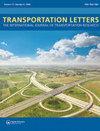Intelligent driving model considering vehicular dynamics and heterogeneous road environments
IF 3.3
3区 工程技术
Q2 TRANSPORTATION
Transportation Letters-The International Journal of Transportation Research
Pub Date : 2025-01-02
DOI:10.1080/19427867.2024.2329469
引用次数: 0
Abstract
Understanding vehicles’ movement in complex environments becomes cruical with the fast development of connected automated vehicles (CAVs). Current microscopic traffic flow models lack consideration for vehicle dynamics and complex road topologies. This study develops a model addressing these issues, retrieving vehicles’ maneuvers and predicting vehicles’ two-dimensional motion. It introduces a two-dimensional intelligent driving model utilizing steering angle and acceleration as control inputs. Intricate road topologies are represented with potential fields and a virtual boundary to capture the heterogeneous environment’s complexity. A driving potential field model is also developed for off-ramp areas. Model parameters are optimized with the dynamic time warping (DTW) and particle swarm optimization (PSO) algorithm. Furthermore, model predictive control (MPC) enhances the realism of the model’s output. Field validation results demonstrate that the proposed models can accurately describe vehicles’ two-dimensional movement in intricate environments, offering valuable support for research on heterogeneous traffic flows for CAVs and CVs.
考虑车辆动力学和异构道路环境的智能驾驶模型
随着互联自动驾驶汽车(CAV)的快速发展,理解车辆在复杂环境中的运动变得至关重要。目前的微观交通流模型缺乏对复杂环境的考虑...
本文章由计算机程序翻译,如有差异,请以英文原文为准。
求助全文
约1分钟内获得全文
求助全文
来源期刊

Transportation Letters-The International Journal of Transportation Research
TRANSPORTATION SCIENCE & TECHNOLOGY-
CiteScore
6.40
自引率
14.30%
发文量
79
审稿时长
>12 weeks
期刊介绍:
Transportation Letters: The International Journal of Transportation Research is a quarterly journal that publishes high-quality peer-reviewed and mini-review papers as well as technical notes and book reviews on the state-of-the-art in transportation research.
The focus of Transportation Letters is on analytical and empirical findings, methodological papers, and theoretical and conceptual insights across all areas of research. Review resource papers that merge descriptions of the state-of-the-art with innovative and new methodological, theoretical, and conceptual insights spanning all areas of transportation research are invited and of particular interest.
 求助内容:
求助内容: 应助结果提醒方式:
应助结果提醒方式:


